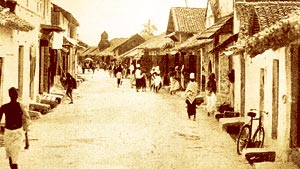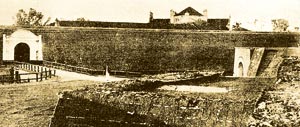“Convoy ahead! Please dim your lights.” A military motor-cyclist was speaking.“Get off the road! Hurry!” ordered another.
“ …….. if you don’t,” cheerfully cut in a third, “I’ll have those d…d lights of yours smashed.”
The first Jaffna journey was going to be historic, anyhow. Up to the time we ran into an unexpected convoy which materialized out of the Vanni night two months ago, we had been good Samaritans on our way. Once it was over a lorry a-fire; at another time to a high officer who had stuck petrol-less in the gathering dusk, well away from the nearest hut. So, we indignantly felt, the threat of these fighting men was not reasonable; and, to be truthful, it did not deter our driver.
 |
| Jaffna in the old days |
 |
| The Jaffna fort: Mark of the Dutch. Pictures from Twentieth Century Impressions of Ceylon |
 |
| Tranquil waters: The Jaffna lagoon |
The real thrill lay ahead. We had not gone far after the convoy had rumbled past us when we noticed a brownish object quietly creeping out of the shadows on our right. It emerged ever so softly and climbed up the bank of the road. The lights of an oncoming vehicle revealed it to us as a huge leopardess with a belly as burdened as almost to brush the surface of the road. Both vehicles stopped dead.
The beast crossed our path, looking first right and then left in correct pedestrian manner. In impressive leisureliness it was indeed an aristocrat of the jungle. For a brief while, in the purdah of a sheltering tree, it watched the cars, and then it padded noiselessly away on its own business.
Mankulam Rest House in the late hours was not very cheering either with board or bed. Besides, we had to show some consideration to later arrivals, an entire family stranded by the waywardness of a motor car. Here again we had to lend a helping hand, and midnight was well past when we arrived at Elephant Pass. The writer of a series of articles in the “Ceylon Daily News” had given the place some status in spookdom. However, the ceaseless music of the lively lagoon and the cool restfulness of the Dutch surroundings brought us delicious sleep free from interruptions by unwanted visitants.
The tiny fort is veritable romance in the half-light of dawn. The alternating shades of white, grey and black, the cutting lines of rampart and embrasure which the curves of the towers soften add to the picturesqueness of this soothing romance of Dutch days before our world invented the severe lines of its buildings.Jaffna is coolest in December. But even at the time of our arrival it had none of the fierceness which one associates with the land of palmyrah and sand-dune.
We entered the city to music. A high-powered hornet, toxically the seventh part of a live cobra, dive-bombed and delivered a telling attack on the shin of a woman passenger. It missed a lot, in its hurry to return to its base. The afflicted female howled in agony. Her shin started swelling in little time.
We entered the town and sought out a medicine-shop. Followed a detailed recital of the happenings; and we solicited a trial of one of the numerous drugs whose varied virtues help to line the pockets of newspaper proprietors. The first question of the dispenser was fairly startling.
“Motor accident? Nasty cuts?”
However, the treating was more to the point; his generous offer of free refreshment was also an unexpected joy.
In Jaffna the man from the south gets a feeling of nostalgia. The market is like that of his home town. The houses are familiar – Dutch, tall-pillared, substantial; the men lithe-bodied and tall, in attire free and easy; their eyes piercingly intelligent, with a dash of impertinent independence. In more respects than one generally notices, the north and south of Ceylon come together to a remarkable degree.
The landscape is rather complicating. But if areca and jak could be thrown into the suriya and margosa pattern, palmyrah obtrudes less, and more females than of the variety that are draped arm-pits below take the road, the parallel would run closer.
Within the enclosures of dried palm-leaf, beyond quaint and elaborate porches of the same stuff, you come to learn (though not to see) that the town is a place of permanent residence. The fields themselves are fenced in; so are even palmyrah gardens which are shut in by lime-stone fences.
It was by trespassing that I could take a picture of the Jaffna variety of rusty sheep. This small livestock industry, by the way, must be fairly old. An English writer of the early 19th century recommended a trial of these animals in the central highlands, after the occupation of Kandy. To a query as to their exact use came a typical reply.
“We don’t have to buy manure for our fields, master. We let these creatures graze on the stubble of the fields.”
The late Chas Vanderwall of the Education Department once returned from a holiday in Holland, and when he went back to Jaffna found how remarkably similar the two peoples were both in character and in their attitude to the land. The town is steeped in the aroma of the seventeenth and eighteenth century Hollander of Ceylon. “There is no town,” wrote H.W. Cave, “which still bears on its features the impress of the Dutch occupation so completely as does Jaffna.”
If the visitor but looks right and left in Main Street he will see how true this statement is. Fine old gables o’ertop broad roofs beneath them; the close lathes and heavy beams of these latter are supported by stout well-turned pillars of houses whose massive doorways and windows are set in thick walls. Well could the old house-holder have said that this house was his castle. On the wide brick-floored verandah of her home one could picture mevrouw sitting while a dark-hued slave fanned her or handed out delicious sweets from the assortment on the solid tea-poy beside her. If the soft Christmas breeze did not close her eyes, she would, perhaps, be watching mynheer making his way home from the lowering fort that stood four square to the winds against any foolhardy Portuguese who would dare a surprise attack.
The early eighteenth century fort is invested with extraordinary charm. In trim compactness it rather comes near the Star Fort at Matara than the massive Galle structure. But the unkempt town within is the fly in the ointment. A lovely moat sets off this gem among our Dutch forts.
To come to man. Of the northern man’s characteristic, euphemistically styled thrift, I had unusual experience. The man-in-the-street was just as warm and effusive a host as elsewhere. Here it was a spontaneous invitation to share a homely meal, or there quick willingness freely offered to as some service. He would not wait for even a “Thank you” at the end of it. Whatever the racial line, the Easterner was a genuine host. On the topic of his industry, nevertheless, I consider him over-rated.
If you would make the desert yield fruit you would have to toil and moil, wherever you may happen to be, in north Ceylon or south. That is why, in other circumstances, the Sinhalese man works when he chooses to. It is necessity that has made the virtue. The same struggle with Nature is the reason why the northerner is a stern realist, who would seek a quid pro quo before he undertakes a job. Calculation is part of his psychological make-up.
Simplicity, too, is a keynote of the men’s character. You lose your way and wonder how you could right yourself in parts the language of which you do not speak. Diffidently you try English on the figure that is approaching, dubiously clad in some yard’s length or so of calico, white strip on shoulder. The recoil is sudden and sharp. The apparent illiterate speaks it as fluently as you yourself do. Up there in Jaffna clothes do not make the man.
He is also an individualist; his sense of proprietorship is highly evolved. The isolating fence bears witness to that. At the same time he is full of awareness, which is possibly due to the interest taken in politics.
Quite the Scotsman a good deal, arguing included. In the quondam Sinhalese village of Chunnakam there are two reading rooms organized by the locals. Grandsires no less than the young patronize them. In fact, age seems a power in society, and it is the patriarch who lords it on the streets.
Doubtless also matriarchy is strongly entrenched behind the leafy ramparts of this province, whose manhood is dispersed in the roomier regions farther south.
Architecturally Jaffna is a disappointment. She should have reared splendid temples of her special faith, so that we could have before us something of the poetry that lives in the stone temples of Polonnaruwa, though in ruin for nigh a millennium. If stone is obtained from outside, her landscape seems just created for the kovils of Hinduism.
The level ground and the clear air cut by palmyrahs are artistically ideal for the upraising of stone temples with their lofty gopurams against the vast sky. The remnants of Portuguese occupation at Kankesanturai witness the departure from one tradition. Its modern light-house symbolizes the new. It is a beacon to Mother India, lighting the way of love across the narrow blue to the home of her daughter, the Lady Lanka. |



